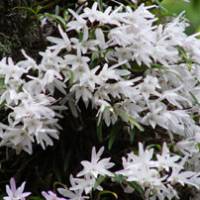Dear Alice,
Can you please find out what the heck I saw on Mount Takao on the outskirts of Tokyo? Last spring, about this time of year, I was on a trail with a lot of other hikers lugging cameras and tripods. All of a sudden everyone got very excited. Not knowing Japanese, I had no idea what they were talking so animatedly about, but one lady directed my attention to a group of pinkish white flowers high up in a fir tree. I think she was trying to tell me the name of the flower, which sounded something like "sankukuran." Everyone was taking pictures. Not knowing what else to do, I took one too.
Leon de O., Tokyo
Dear Leon,
I'm no authority on flowers but I do know that "ran" means "orchid" in Japanese. It seemed highly unlikely that you had stumbled upon a wild orchid, and in Tokyo of all places, but not knowing what else to do, I pursued that thread first. Lo and behold, with only a little searching, I had soon sniffed out that the flower you saw is indeed an orchid: Dendrobium moniliform. In Japanese, it's called sekkoku, or sekkoku-ran. So you heard the lady almost right.
Wild orchids in Tokyo! Who knew? Well, lots of people, it turns out. After only a bit more digging I learned that sekkoku is one of the big late-spring draws at Mount Takao, at least for flower enthusiasts. Blooming time varies year by year, depending on weather, but generally the sekkoku on Mount Takao strut their stuff from late May through the first half of June.
To find out more, I phoned up the Tokyo Metropolitan Government's Takao Visitor Center at the top of Mount Takao and spoke to one of the guides there, Takao (no relation to the mountain) Fujino.
"We do indeed get a lot of visitors in spring who come specifically to see the sekkoku blooming," he confirmed. "It's rare to be able to observe wild orchids so close to home, so the flowers draw visitors not only from throughout greater Tokyo but also beyond."
This particular orchid, Fujino explained, is a chakusei shokubutsu (epiphytic plant) that tends to lodge in large trees. It derives only physical support from the host, not water or nutrition, and generally doesn't harm the tree, so it shouldn't be confused with a kisei shokubutsu (parasitic plant).
"Virtually all of the sekkoku on Mount Takao lodge in cedar trees," he said. "When they're in bloom, it looks as if the cedars themselves are flowering. It's really quite an unusual sight."
To get your own gander, go up the Omotesando Trail (Trail 1), one of seven hiking trails on Mount Takao. The trail head is at the far right of the open space near the bottom of the cable car, a short walk up the hill from the Keio Line's Takaosanguchi Station. Continue along the trail for about 15 minutes until you come to a stand of large cedar trees that provide a home to some of the orchids. Another good sekkoku-viewing spot is about an hour's walk along the same trail, at the big cedars just before the Yakuoin temple. It's also possible to see sekkoku along the Biwa Waterfall Trail (Trail 6), in the cedars before and after the Oyama Bridge. This is a 40 minute walk from the trail head, which you can find at the left of the cable car station at the bottom. Because the flowers are high in trees which are themselves off the trail, you can't get close enough to get a really good look. Fujino recommends bringing along binoculars, and if you want to take photos, a good telephoto lens.
For visitors who don't have the time or stamina to tromp up and down trails in pursuit of sekkoku, the staff has thoughtfully placed specimens at both cable car stations, Kiyotaki Station at the bottom, and Takaosan Station at the top. Look for the flowers up in cherry trees.
Until I started working on your question, I had an image of orchids — admittedly uninformed — as hot-house plants that need tropical conditions. But the sekkoku orchid thrives not only on the slopes of Mount Takao but in colder climes as well. On Japan's main island of Honshu, its range extends well north of Tokyo. It also grows on Shikoku and Kyushu islands and is native to parts of China as well.
On Mount Takao, the sekkoku is protected and celebrated, but it has a couple of cousins in dire straits. In Okinawa, there is a closely related orchid called Okinawa sekkoku (D. Okinawense Hatusima et Ida) which is a critically endangered species. It currently grows only in a limited habitat on the main island of Okinawa, and its recent discovery in the wild in Taiwan was enough to rate a write-up in a scientific journal.
Another at-risk relative is the kibana sekkoku (D. tosaense Makino), which is still occasionally found growing in parts of Shikoku and Kyushu but is on the environment ministry's "Red List" of threatened Japanese wildlife.
One final note of interest: sekkoku has medicinal value. In traditional Chinese and Japanese medicine, the stems were dried and steeped to make a tea that improves digestion, strengthens the joints and even improves sexual function.
For information on Mount Takao, including trail maps in English, visit www.takaotozan.co.jp Puzzled by something you've seen? Send a description, or better yet a photo, with the address where you saw it to [email protected] or Alice Gordenker, A&E Dept., The Japan Times, 4-5-4 Shibaura, Minato-ku, Tokyo 108-8071


















With your current subscription plan you can comment on stories. However, before writing your first comment, please create a display name in the Profile section of your subscriber account page.